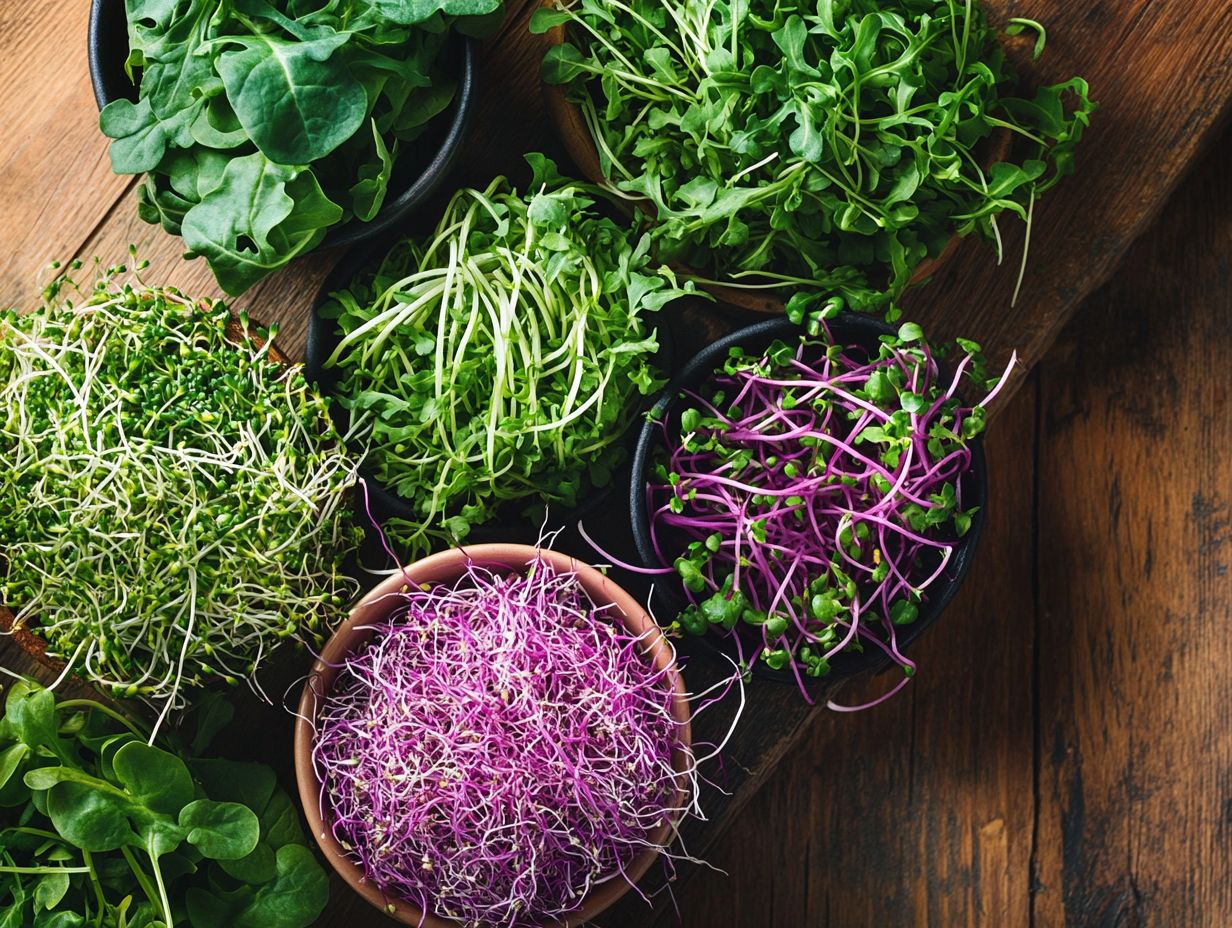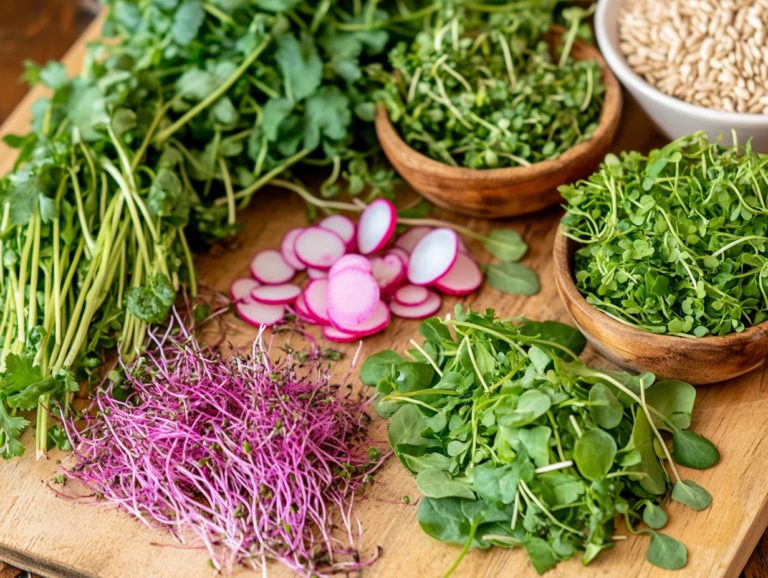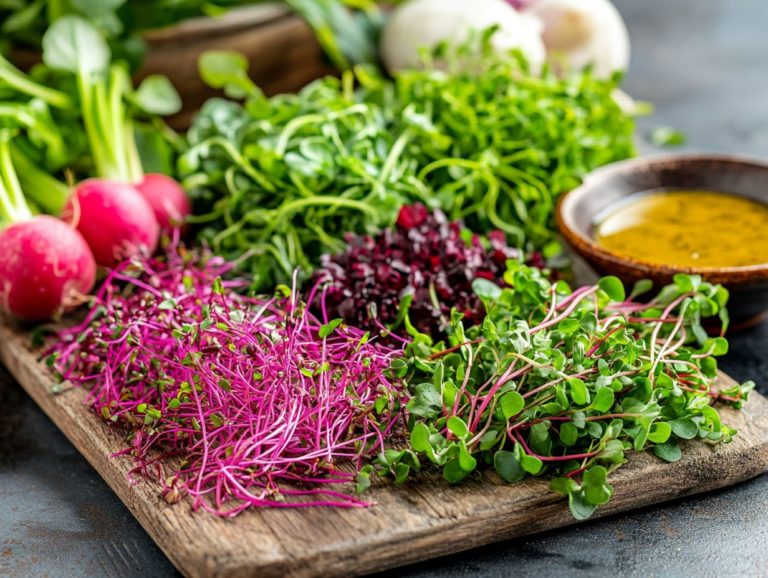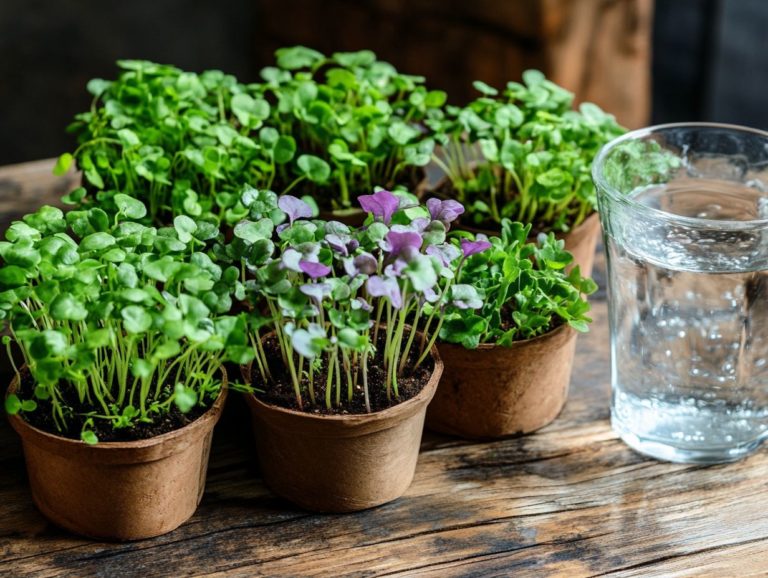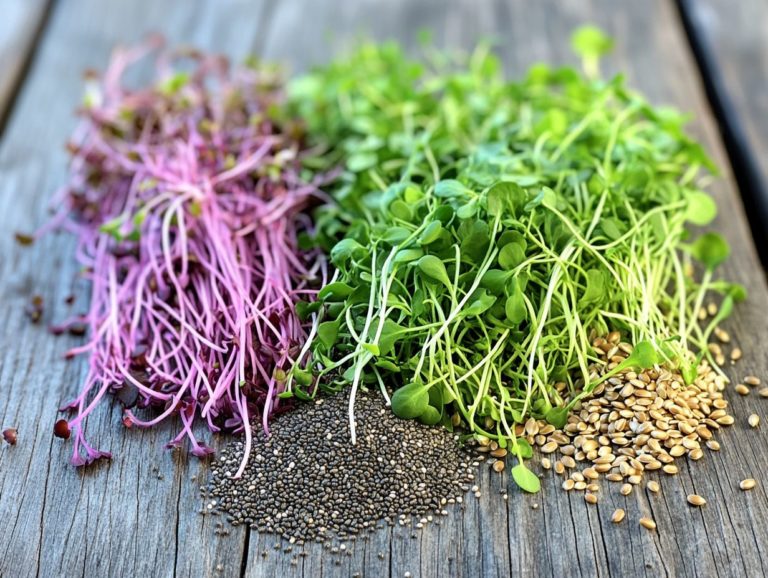The Best Microgreens for Bone Health
Microgreens are far more than mere trendy garnishes; they are nutrient powerhouses that can profoundly enhance your bone health.
Delve into the top 15 microgreens, such as broccoli and kale, that you can seamlessly integrate into your daily meals.
Learn how these petite greens contribute to robust bones, the essential nutrients they offer, and any important precautions you should consider.
Unveil the extraordinary health benefits of these miniature superfoods that can elevate your well-being!
Contents
- Key Takeaways:
- 1. Broccoli Microgreens
- 2. Kale Microgreens
- 3. Radish Microgreens
- 4. Cabbage Microgreens
- 5. Beet Microgreens
- 6. Alfalfa Microgreens
- 7. Sunflower Microgreens
- 8. Pea Shoots Microgreens
- 9. Mustard Microgreens
- 10. Arugula Microgreens
- 11. Collard Green Microgreens
- 12. Spinach Microgreens
- 13. Chia Microgreens
- 14. Amaranth Microgreens
- 15. Wheatgrass Microgreens
- What Are Microgreens and How Do They Benefit Bone Health?
- How Can Microgreens Be Incorporated into a Diet for Bone Health?
- Are There Any Risks or Precautions to Consider When Consuming Microgreens?
- What Are the Other Health Benefits of Microgreens?
- Frequently Asked Questions
- 1. What are the best microgreens for improving bone health?
- 2. How do these microgreens benefit bone health?
- 3. Can microgreens really help prevent osteoporosis?
- 4. Are there any other microgreens that are good for bone health?
- 5. How should I incorporate microgreens into my diet for optimal bone health?
- 6. Are there any precautions I should take before consuming microgreens for bone health?
Key Takeaways:
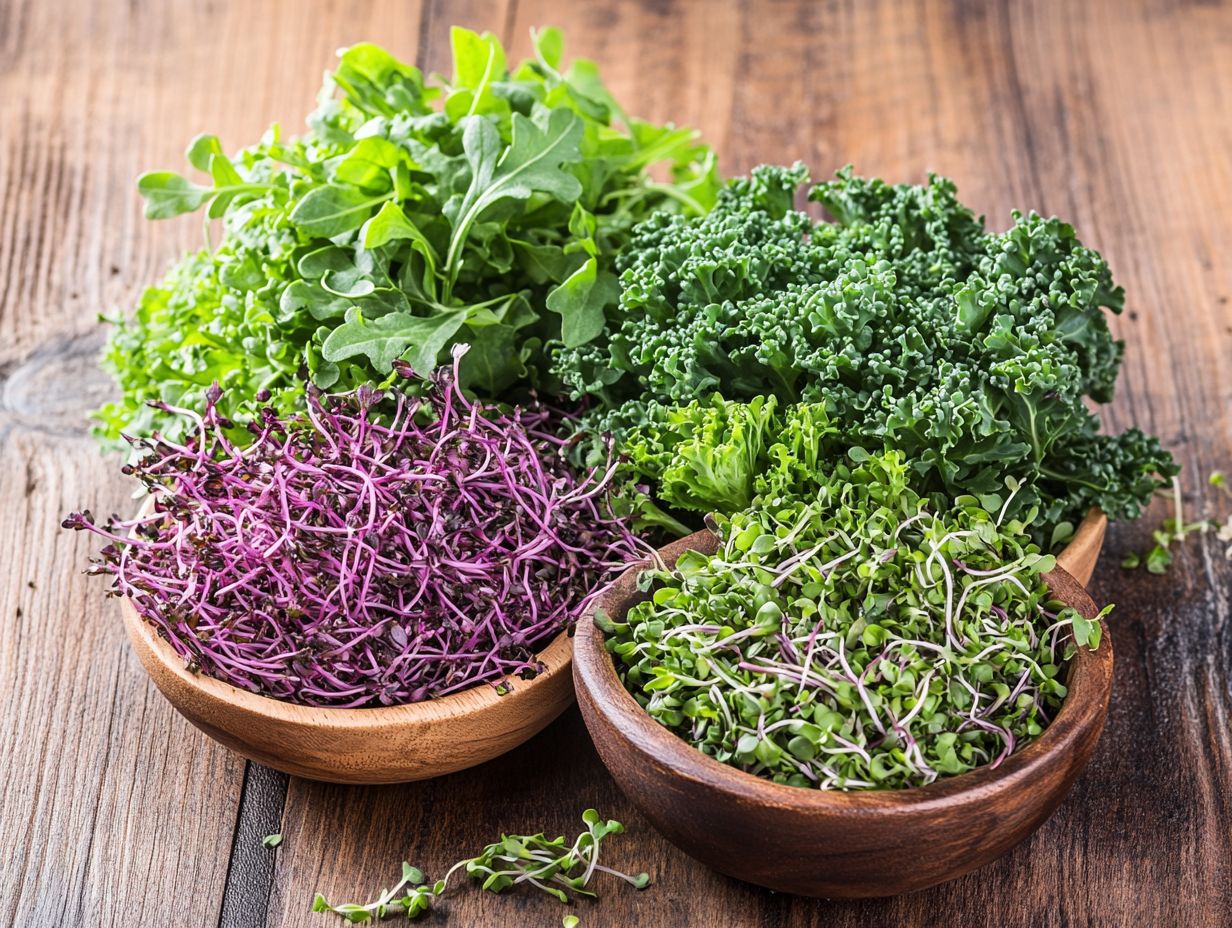
- Broccoli microgreens are rich in vitamin K, which helps to maintain strong bones and may reduce the risk of fractures.
- Kale microgreens are a good source of calcium, essential for strong bones.
- Radish microgreens are high in antioxidants, promoting bone health.
1. Broccoli Microgreens
Broccoli microgreens present an exceptional blend of flavor and remarkable health benefits. They are a favored choice for home gardeners and health enthusiasts keen on integrating healthy foods into their diets.
These petite, edible greens are brimming with vitamins, antioxidants, and minerals that bolster overall well-being. They are a true powerhouse in the world of microgreens.
Rich in vitamin K, they play a vital role in bone health and proper blood clotting. The sulforaphane they contain also contributes to their cancer-fighting prowess, while a variety of antioxidants work to combat oxidative stress in your body.
You can use these microgreens to enhance your salads, sandwiches, and smoothies with their bold, peppery flavor. If you’re interested in growing your own, you ll find that microgreens are relatively easy to cultivate at home, requiring minimal space.
By using organic seeds and providing adequate light, you can significantly enhance their flavor intensity, transforming them into a nutrient-rich addition to any meal.
2. Kale Microgreens
Kale microgreens offer a remarkable nutrient profile, delivering substantial health benefits that enhance immune function and provide antioxidant protection. It’s no wonder they attract both health-conscious consumers and home gardeners.
Those vibrant green leaves are packed with vitamins, minerals, and anti-inflammatory properties. They make a versatile addition to a variety of dishes.
These tiny greens pack a powerful punch of vitamins A, C, and K, along with essential minerals like calcium and magnesium. Such nutrients play a crucial role in maintaining a healthy gut flora, promoting digestion, and potentially lowering the risk of certain cancers through their detoxifying effects.
If you’re interested in growing these nutritious gems indoors, start with a shallow tray filled with potting soil, ensuring they receive adequate light for optimal results.
In the kitchen, you can use these microgreens to elevate your salads, sandwiches, and smoothies. They not only boost nutrition but also add vibrant color and a subtle, peppery flavor that enhances any meal.
3. Radish Microgreens
Radish microgreens are truly a culinary gem, celebrated for their peppery flavor and vibrant hues. They’re not just a favorite among chefs; health enthusiasts adore them as well, all thanks to their remarkable health benefits and effortless cultivation.
These tiny plants are brimming with antioxidants and essential vitamins, enhancing both the flavor and nutritional value of your meals.
Beyond their delightful taste, they play a vital role in promoting heart health, offering key nutrients that can help lower cholesterol and boost circulation. Their high fiber content is an added bonus, supporting digestive health and overall wellness.
If you’re keen on cultivating radish microgreens, start them indoors in shallow trays with a quality soil mix for successful growth.
When it’s time to incorporate these greens into your meals, they can elevate an array of dishes from salads and sandwiches to smoothies and garnishes adding a fresh, zesty kick that s as visually appealing as it is nutritionally enriching.
Start your microgreens journey today and taste the difference they can make in your meals!
4. Cabbage Microgreens
Cabbage microgreens are a delightful addition to your kitchen. They are celebrated for their satisfying crunch, versatile culinary uses, and impressive health benefits. Packed with nutrients, these baby greens are especially rich in vitamin K, making them a fantastic choice for health-conscious eaters. Growing them at home is a breeze!
In addition to their vibrant flavor and texture, cabbage microgreens have anti-inflammatory properties, making them a powerful ally in your quest for better health. Scientific studies suggest that these tiny greens could even play a role in cancer prevention because they contain antioxidants and glucosinolates, which are natural compounds found in some vegetables that may help prevent cancer.
If you’re interested in cultivating these microgreens indoors, you’ll be glad to know they require minimal space and thrive beautifully on a sunny windowsill or under fluorescent lights. With varieties like red cabbage, savoy cabbage, and classic green cabbage, you have a delightful spectrum of flavors and colors to explore. Don t miss out on the chance to elevate your dishes with these vibrant microgreens!
5. Beet Microgreens
Beet microgreens are not just a feast for the eyes with their vibrant hues; they also offer a wealth of nutritional benefits that can elevate your diet with organic, nutrient-dense foods. These tiny powerhouses are loaded with potassium, iron, and dietary fiber, making them an exceptional choice for anyone eager to enhance their health.
What sets beet microgreens apart are their remarkable antioxidant properties. These properties can be instrumental in promoting heart health by decreasing oxidative stress in the body.
Incorporating beet microgreens into your meals is simple. You can sprinkle them over salads, blend them into smoothies, or use them as a delightful garnish for soups and sandwiches, all while boosting flavor and nutrition.
For those who want to cultivate their own beet microgreens at home, it’s important to provide well-drained soil, ample sunlight, and consistent moisture to ensure a thriving crop. With just a little care, you can enjoy these nutrient-rich greens straight from your kitchen!
6. Alfalfa Microgreens
Alfalfa microgreens are renowned for their delicate flavor and impressive nutritional profile. They offer a wealth of health benefits that support immune function and heart health, making them a quintessential addition to any healthy diet. These tiny greens are brimming with vitamins and minerals, especially vitamin K, which elevates their status as a must-have in your health food repertoire.
But there s more to them than just nutrition. Alfalfa microgreens have gained attention for their potential role in cancer prevention, thanks to their antioxidants that may help fight off harmful substances in your body and reduce inflammation. Their high fiber content also enhances gut health by promoting digestive regularity and nurturing beneficial gut bacteria.
Cultivating alfalfa microgreens is surprisingly simple and requires minimal space and resources. This is perfect for urban gardeners looking to green their thumbs. As versatile culinary gems, they can be easily incorporated into salads, sandwiches, and smoothies, delivering a delightful crunch and a nutrient boost that health-conscious home cooks adore.
7. Sunflower Microgreens
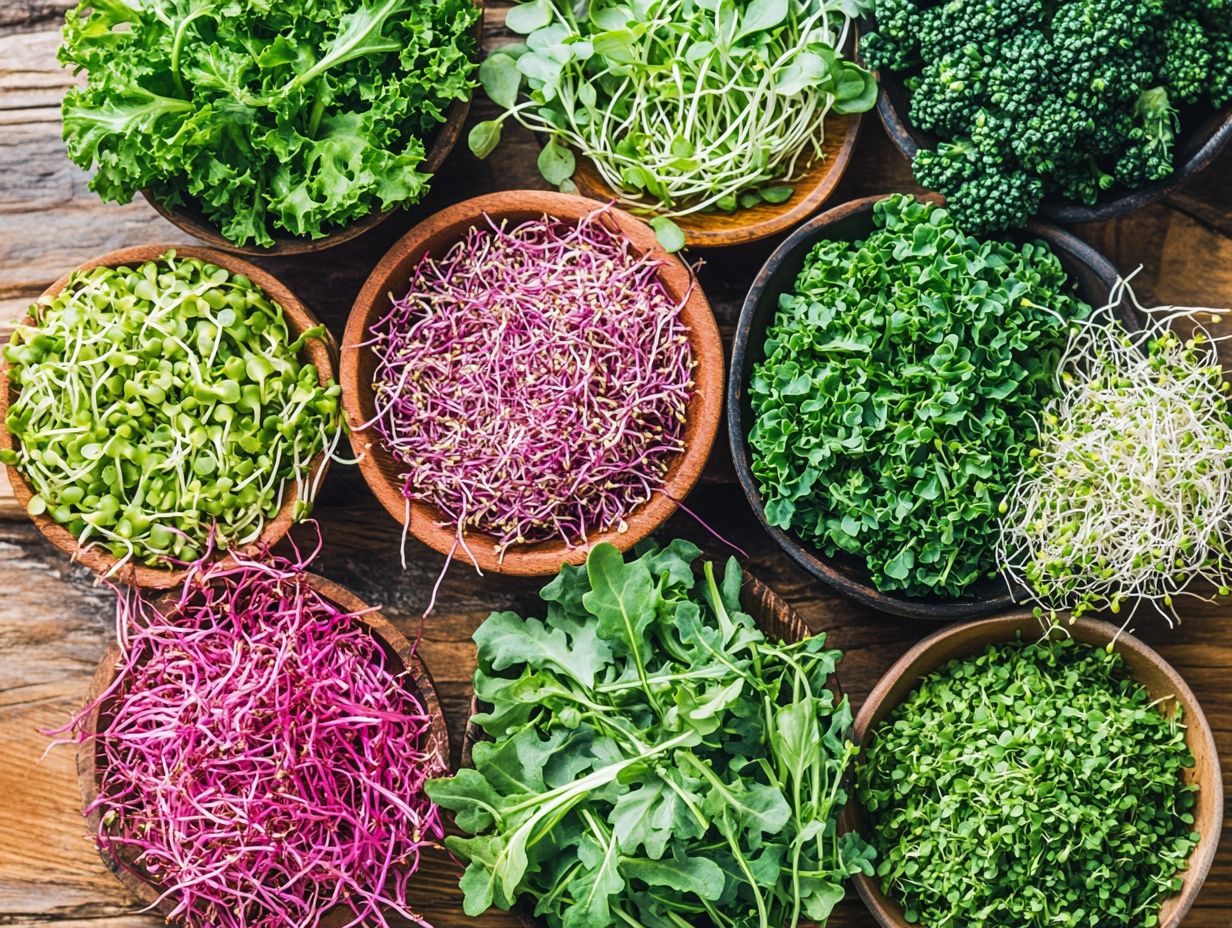
Sunflower microgreens are a tasty treasure in your kitchen. They are celebrated for their nutty flavor and crunchy texture. These greens enhance salads and sandwiches while offering impressive health benefits tailored to your modern lifestyle.
Packed with micronutrients vitamins and minerals essential for health and antioxidants, these tiny plants are your secret weapon for better health! Rich in vitamins A, C, and E, sunflower microgreens bolster your immune function and help fend off seasonal illnesses. They also contribute to healthier skin.
This nutrient-dense superfood is not just a treat for your taste buds; it provides essential fatty acids that support heart health and act as a natural energy booster. Want to grow these microgreens at home? It s easy! Just use a shallow tray with good drainage and find a sunny spot for thriving growth.
Incorporating sunflower microgreens into your meals is a breeze. They can elevate the nutritional value of smoothies, enhance the flavor of avocado toast, or serve as a vibrant garnish for soups. Healthy eating is not only accessible but genuinely enjoyable!
8. Pea Shoots Microgreens
Pea shoots microgreens are a delightful addition to your cooking options. They offer a tender and flavorful sweetness that complements various dishes. Packed with health benefits, they boast high levels of vitamin K and dietary fiber, making them a nutritious choice for anyone passionate about organic ingredients.
Rich in antioxidants, these little greens play a significant role in promoting heart health by reducing inflammation and cholesterol levels. This helps maintain a balanced cardiovascular system. With a quick growth cycle, cultivating pea shoots indoors is feasible and rewarding. All you need is a shallow container, some potting mix, and a sunny windowsill.
Their versatility is truly remarkable! Whether tossed into salads, layered in sandwiches, or stir-fried to perfection, pea shoots elevate your everyday meals with vibrant flavor and crisp texture. Incorporating them into your diet is a proactive step toward enhancing your health.
9. Mustard Microgreens
Mustard microgreens stand out for their zesty flavor and impressive nutritional benefits. They offer antioxidant protection and anti-inflammatory properties, making them an invaluable part of your diet. These vibrant greens are easy to cultivate and elevate your culinary experiences.
Packed with vitamins A, C, E, and K, along with essential minerals like calcium and magnesium, mustard microgreens can significantly bolster your immune system. Their glucosinolates have shown promise in studies focused on cancer prevention and promoting detoxification within the body.
To cultivate mustard microgreens with ease, soak the seeds for a few hours before planting them in a shallow tray filled with soil. Ensure they receive adequate light and moisture.
In the kitchen, these greens truly shine! Use them in salads, sandwiches, or as a delightful garnish atop soups and main dishes. They enhance both flavor and nutritional value in every bite.
10. Arugula Microgreens
Arugula microgreens are renowned for their distinctive peppery flavor and impressive array of health benefits. They are an excellent addition to your meals if you’re aiming to elevate your diet with nutrient-packed foods. Packed with antioxidants and vitamins, these tiny greens are favorites among chefs and health enthusiasts alike.
Beyond their culinary charm, arugula microgreens play a vital role in supporting your gut health. They foster a healthy balance of gut bacteria, which can lead to improved digestion and overall wellness. Their powerful anti-inflammatory properties might also help mitigate chronic inflammation, a condition connected to various health challenges.
If you re considering growing these greens at home, you’ll find they flourish in a sunny spot and need minimal space ideal for urban gardening. Incorporating arugula microgreens into your daily meals is easy. Toss them into salads, layer them in sandwiches, or even blend them into smoothies for a nutritious kick!
11. Collard Green Microgreens
Collard green microgreens are a remarkable addition to your diet, offering a wealth of health benefits that elevate your meals, especially if you re keen on organic ingredients. Bursting with vitamin K, calcium, and antioxidants, these greens enhance your overall well-being and can thrive in compact indoor spaces.
Their impressive fiber and flavonoid content plays a significant role in preventing heart disease by improving cholesterol levels and promoting healthy blood circulation. If you re interested in growing these delightful greens, starting them in a simple soil mix with plenty of sunlight and consistent watering can yield outstanding results.
As a culinary enthusiast, get creative with these microgreens in salads, sandwiches, or as a vibrant garnish. Their mild, slightly sweet flavor beautifully complements a wide array of dishes. For an extra nutritious kick, consider blending them into smoothies or tossing them into saut s for added texture and health benefits.
12. Spinach Microgreens
Spinach microgreens are an exceptional source of nutrition. They are brimming with health benefits that cater to a variety of dietary needs. These small, vibrant greens are packed with essential vitamins and antioxidants. You can use them in many tasty dishes.
Rich in vitamins A, C, and K, along with folate and iron, spinach microgreens support your digestive health by promoting beneficial gut bacteria. Their impressive array of antioxidants plays a vital role in enhancing your immune function, helping your body fend off infections and diseases. These microgreens also contain compounds that may inhibit cancer cell growth, making them a proactive choice in your journey toward disease prevention.
To grow them effectively, consider using deep trays filled with well-draining soil. Ensure they receive plenty of light. Incorporating spinach microgreens into your salads, smoothies, or as garnishes can elevate everyday meals, infusing them with both flavor and nutritional value.
13. Chia Microgreens
Chia microgreens deliver a remarkable fusion of flavor and health benefits. They make a coveted addition to your culinary creations and health-focused meals. With their abundant omega-3 fatty acids and antioxidants, these tiny powerhouses effortlessly elevate your nutritional game.
Loaded with vitamins A, C, and E, these microgreens promote heart health by reducing inflammation. They also supply essential nutrients that contribute to your overall well-being. If you’re keen on cultivating chia microgreens indoors, a sunny windowsill or some grow lights will do the trick, requiring minimal space and care.
In the kitchen, sprinkle them on salads, toss them into smoothies for an extra kick, or use them as a vibrant garnish for soups and sandwiches. They boost both flavor and presentation with their striking green hue.
14. Amaranth Microgreens
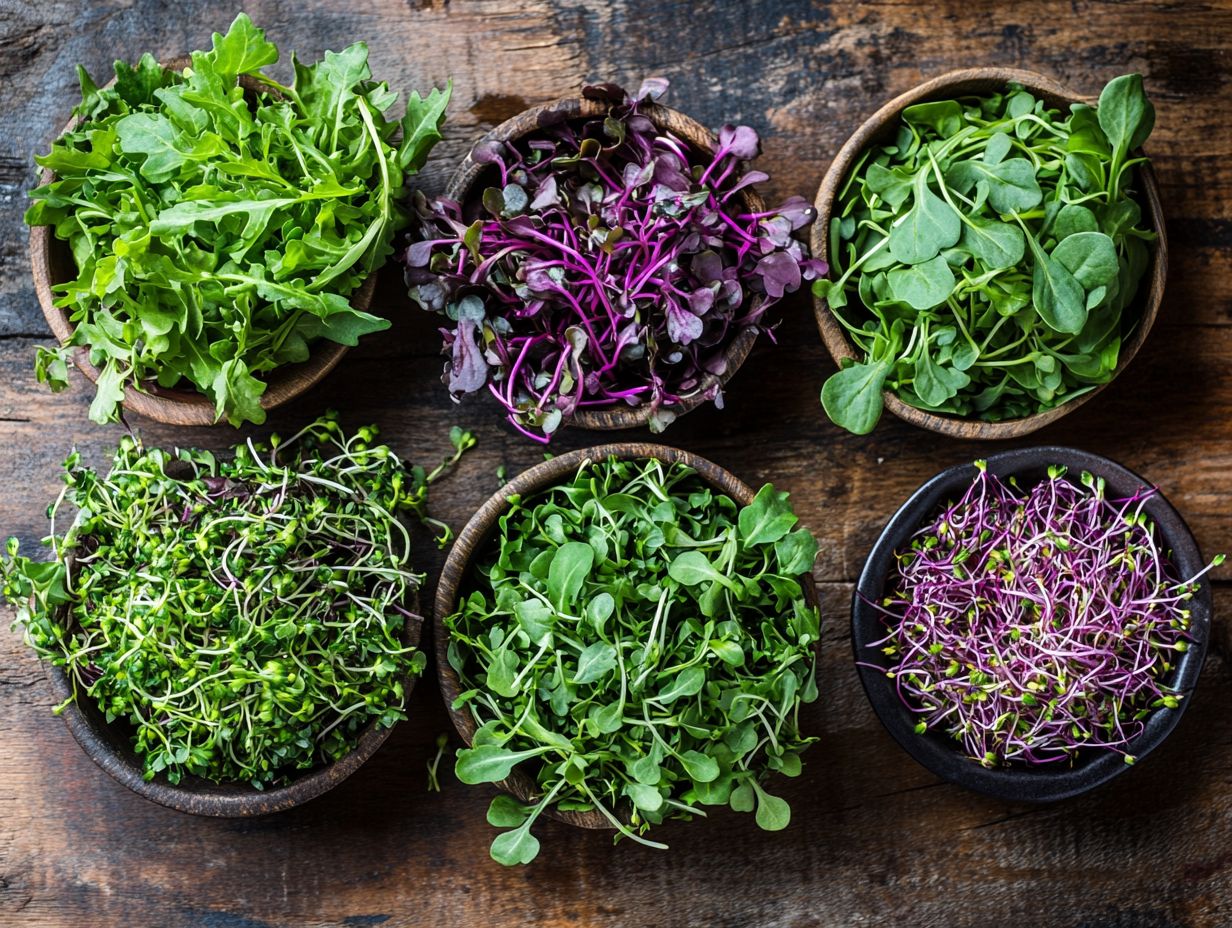
Amaranth microgreens are becoming a sensation. Their vivid colors and impressive health benefits make them a wealth of vitamins, minerals, and antioxidants that suit your health-conscious lifestyle.
These microgreens are loaded with essential nutrients like vitamins A, C, and E, along with magnesium and iron. Their strong anti-inflammatory properties can help reduce the risk of chronic diseases, making them a smart addition to your diet. Research even suggests that incorporating them into your meals may provide protective benefits for heart health, including lowering cholesterol levels and enhancing blood circulation.
Ready to grow your own? Cultivating amaranth microgreens is a fun and easy way to enjoy fresh greens at home! They thrive in a sunny spot with well-drained soil and require nothing more than a light misting of water. You can easily incorporate them into salads, sandwiches, or use them as a stunning garnish for soups, enjoying their vibrant flavor while reaping all the health benefits they offer.
15. Wheatgrass Microgreens
Wheatgrass microgreens are remarkable! They are celebrated for their detoxifying properties and impressive nutrient profile. Packed with vitamins, minerals, and antioxidants, these petite greens are a powerful addition to your diet, offering myriad health benefits that support overall wellness and vitality.
Wheatgrass plays a vital role in cleansing your body. The chlorophyll content helps flush out toxins and impurities, promoting a healthier digestive system. Many find that adding these microgreens to their daily routine enhances energy levels, making them ideal for anyone looking to boost their physical and mental performance.
To enjoy these benefits, consider growing wheatgrass at home! You only need a sunny spot and a few simple supplies. Blending them into fresh juices or smoothies is an excellent way to relish their unique flavor while amplifying your nutritional intake. Just a handful can transform your morning drink into a vibrant superfood boost.
What Are Microgreens and How Do They Benefit Bone Health?
Microgreens are young, edible plants that have gained popularity for good reason. They promote bone health with their rich vitamins and minerals. Whether it s kale or broccoli, these tiny greens not only burst with flavor but also support your long-term wellness.
Known for their vibrant colors and intense flavors, microgreens make an excellent choice for salads, sandwiches, and even smoothies. They are particularly notable for their high levels of calcium and vitamin K crucial for maintaining strong bones and preventing conditions like osteoporosis. For health enthusiasts, exploring the top microgreen varieties such as sunflower and pea shoots is a delicious way to significantly contribute to your daily intake of these vital nutrients.
Adding microgreens to your meals is easy! Sprinkle them over salads or blend them into creamy sauces to boost both the nutrition and flavor of your dishes.
What Nutrients Do Microgreens Contain That Promote Bone Health?
Microgreens are a treasure trove of essential nutrients vital for maintaining strong bones, particularly calcium, potassium, and vitamin K. Their remarkable nutrient density makes them an excellent dietary choice for anyone interested in bolstering their skeletal system.
In addition to calcium and vitamin K, varieties like kale microgreens, broccoli, and collard greens are rich in magnesium and phosphorus, both of which support bone density and overall skeletal integrity. Incorporating the top 10 microgreens for nutritional boost can further enhance your diet.
Mixing different types of microgreens, such as beet and sunflower microgreens, into your meals not only enhances flavor but also optimizes nutrient absorption. For instance, a salad adorned with a medley of microgreens and nuts and seeds can become even more beneficial when you consider the best microgreens to grow for storage, transforming it into a nutrient powerhouse!
Incorporating these greens into smoothies, sandwiches, or omelets can seamlessly elevate your balanced diet while benefiting your bone health. By making microgreens a staple in your daily meals, you can fortify your bones and enjoy a multitude of additional health benefits, including improved gut health. For example, consider the best microgreens for reducing stress to enhance your overall well-being.
How Can Microgreens Be Incorporated into a Diet for Bone Health?
Integrating microgreens into your diet for better bone health is not only simple but also a delicious endeavor. It allows you to explore different types of microgreens. These nutrient-packed plants can enhance a variety of dishes, elevating both flavor and nutritional value.
By incorporating a diverse array of microgreens into your meals, you’ll love the health benefits they offer while actively supporting your bone density. For the highest benefits, consider the best microgreens for nutritional value.
These tiny greens, including Brassica vegetables like kale and broccoli, are often brimming with essential vitamins and minerals. They transform everyday recipes into nutrient-rich foods. For example, tossing a handful of arugula microgreens into a fresh salad offers a delightful peppery kick. This addition delivers nutrients that promote strong bones and enhance overall flavor, making them some of the best microgreens for vegan nutrition.
Blending spinach microgreens into your smoothie adds a vibrant touch. It effortlessly boosts your calcium intake and provides essential dietary fiber. For a quicker harvest, explore the best microgreens to grow.
Your sandwiches can also benefit from the addition of radish microgreens and parsley microgreens. They create an appealing crunch and a burst of flavor. The remarkable culinary versatility of these small plants invites experimentation. You can enrich your meals while reaping substantial benefits for your bone health and overall well-being, especially when incorporating the best microgreens for nutrient density.
Are There Any Risks or Precautions to Consider When Consuming Microgreens?
While microgreens offer a wealth of health benefits, it s essential to consider potential risks and take precautions when consuming them. This is especially important for food safety to avoid food poisoning from harmful bacteria.
By ensuring that microgreens are grown and stored correctly and using proper cultivation methods, you can minimize these risks and fully enjoy their nutritional advantages.
These petite greens can sometimes harbor harmful bacteria if they aren t washed thoroughly or if contamination occurs during cultivation. This emphasizes the importance of proper food safety practices. Rinse microgreens gently under cold running water before indulging, especially when considering various cooking techniques.
Proper storage is equally vital. Keeping them in the fridge in a breatheable container helps maintain freshness and reduces spoilage, thereby extending their shelf life.
When shopping at farmers’ markets or health food stores, opt for vendors who prioritize organic practices and uphold clear hygiene standards to enhance your safety.
By being mindful of these precautions, especially in home gardening, you create a safer, more enjoyable experience with these nutrient-dense delights.
What Are the Other Health Benefits of Microgreens?
Beyond their well-known role in promoting bone health, microgreens offer a wealth of additional benefits. They support gut health and enhance immune function while providing robust antioxidant protection. This makes them an invaluable addition to your diet.
These tiny greens not only pack a nutritional punch but also elevate the flavor profile of a diverse array of dishes. Along with their immune-boosting abilities, various microgreens such as broccoli, kale microgreens, and red cabbage microgreens boast remarkable anti-inflammatory properties. For seniors, these benefits are particularly significant, as highlighted in the health benefits of microgreens. These may help reduce the risk of chronic diseases, including heart disease.
Cilantro microgreens stand out for their detoxification support, while sunflower microgreens are a treasure trove of vitamin E and dietary fiber. They contribute to skin health and overall vitality. Additionally, incorporating the best microgreens for higher protein intake can further enhance your nutritional benefits.
Easily integrated into salads, sandwiches, and smoothies, these vibrant greens deliver unique flavors alongside significant health benefits. They enrich your daily meals and support longevity. Their culinary versatility ensures that they are not merely a garnish but a powerhouse of nutrition, including micronutrients and phytonutrients that can elevate your dining experience.
Frequently Asked Questions
1. What are the best microgreens for improving bone health?
The best microgreens for bone health include broccoli microgreens, kale microgreens, watercress, radish microgreens, and beet microgreens for added variety.
Start adding these tiny greens to your meals today for better bone health!
2. How do these microgreens benefit bone health?
These tiny greens are packed with calcium, potassium, and vitamin K key nutrients for strong bones!
3. Can microgreens really help prevent osteoporosis?
Yes, regular consumption of microgreens helps prevent osteoporosis, a common bone disease. They may even play a role in cancer prevention!
4. Are there any other microgreens that are good for bone health?
Yes, beet microgreens, mustard, and sunflower microgreens are great for bone health. They are also known for their bold flavors!
5. How should I incorporate microgreens into my diet for optimal bone health?
You can add microgreens to salads, sandwiches, and smoothies. They also make excellent toppings for soups and omelets.
6. Are there any precautions I should take before consuming microgreens for bone health?
If you have any existing medical conditions, such as heart disease, consult your doctor before adding microgreens to your diet.

